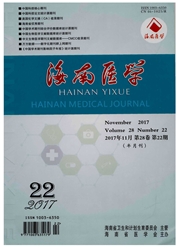

 中文摘要:
中文摘要:
目的评估来氟米特(LEF)联合泼尼松治疗增殖型狼疮性肾炎患者的临床疗效及安全性。方法采用单中心前瞻性研究,纳入我院肾脏内科2013年1月至2015年12月间经肾穿刺病理活检确诊后的增殖型狼疮性肾炎患者30例,采用简单随机法将其分为两组,每组15例,分别使用来氟米特(LEF)联合泼尼松(LEF组)及环磷酰胺(CTX)联合泼尼松(CTX组)进行诱导期治疗24周。定期复查尿常规、血常规、生化、抗ds-DNA定量、补体C3、T细胞亚群、SLEDAI评分及记录不良反应,对比两组患者在不同治疗时间段的各项指标变化,以评价来氟米特对增殖型狼疮性肾炎的治疗有效性及副作用。结果两组患者治疗24周后,24 h蛋白尿定量、红细胞尿、血浆白蛋白、血肌酐及狼疮活跃性指标均较治疗前明显好转,差异均有统计学意义(P〈0.05);治疗8周时,CTX组患者的尿蛋白总缓解率、血浆白蛋白、狼疮免疫指标恢复均优于LEF组,差异均有统计学意义(P〈0.05),但治疗24周结束时两组患者的上述各项指标比较差异均无统计学意义(P〉0.05);两组患者治疗过程中,ALT、白细胞、血红蛋白均无变化(P〉0.05),T细胞亚群各指标较治疗前有所下降(P〈0.05),但两组比较差异无统计学意义(P〉0.05);CTX组患者的各项不良反应均高于LEF组,但差异无统计学意义(P〉0.05)。结论来氟米特对增殖型狼疮性肾炎在诱导期治疗中具有良好的效果。虽然与传统的环磷酰胺治疗相比起效偏慢,但诱导期结束时疗效基本类似,而且副作用、不良反应少于环磷酰胺,提示其值得在增殖型狼疮性肾炎患者中进一步使用。
 英文摘要:
英文摘要:
Objective To evaluate the efficacy and safety of leflunomide (LEF) as an induction treatment for proliferative lupus nephritis (PLN). Methods In a single-center prospective study, 30 patients who had been confirmed with PLN by renal puncture biopsy in our hospital from Jan. 2013 to Dec. 2015 were selected and randomized into two groups, with 15 cases in each group. The two groups were treated with LEF combined with prednisolone (LEF group) and cytoxan (CTX) combined with prednisolone (CTX group), respectively, for 24 weeks. Urine routine, blood routine, blood biochemistry, quantitation of anti-ds-DNA, compliment C3, T-cell subsets and Systemic Lupus Erythematosus Dis- ease Activity Index (SLEDAI) scoring were periodically reviewed. In order to assess the efficacy and safety of LEF as an induction treatment for PLN, all adverse reactions were recorded for comparison between the two groups at different treatment stages. Results The 24-week treatment achieved significant improvement in both groups for 24-hour proteinuria, hemoglobinuria, serum albumin, renal function and lupus activity measurements (P〈0.05). At 8 weeks (the middle stage) of treatment, the total proteinuria, serum albumin and lupus immunoregnlation index of the CTX group were sig- nificantly better than those of the LEF group (P〈0.05). However, at the end of treatment, there was no significant differ ence in efficacy between the two groups (/〉〉0.05). There no significant change in ALT, WBC and hemoglobin during the course of treatment (P〉0.05) in either group, while T-cell subset was decreased in both groups (P〈0.05) after treatment, with no significant difference between the two groups (P〉0.05). Although the CTX group manifested higher adverse ef- fects in all measurements than the LEF group did, there was no statistical significance between the two groups (/'〉0.05). Conclusion LEF has a good efficacy in the induction treatment of PLN. Although it is slower than CTX, LEF has t
 同期刊论文项目
同期刊论文项目
 同项目期刊论文
同项目期刊论文
 期刊信息
期刊信息
